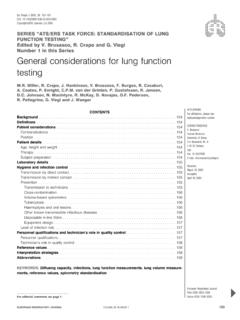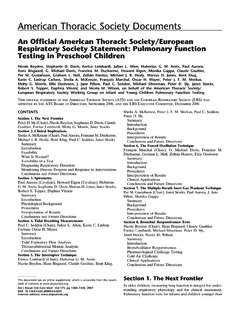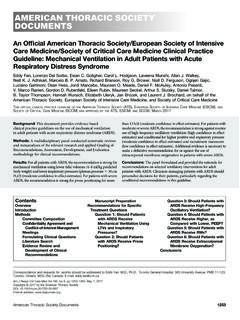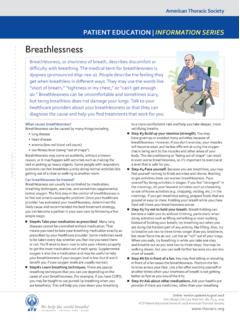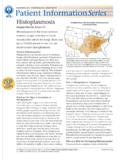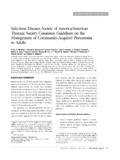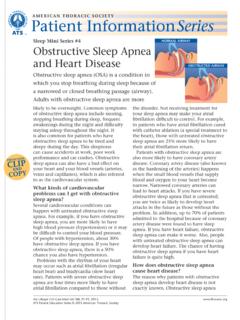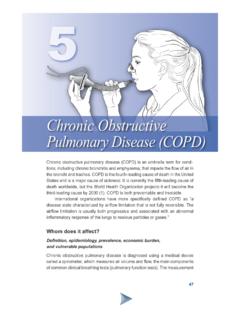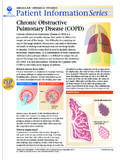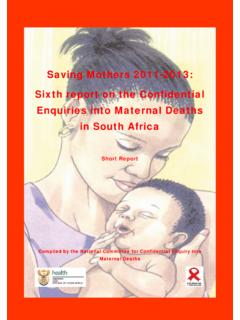Transcription of American Thoracic Societv
1 American Thoracic SocietvGuidelines for Methacholine and Exercise ChallengeTesting-1999 THIS OFFICIAL OF THE American Thoracic society WAS ADORED BY THE ATS BOARD OF DIRECTORS, JULY 1999I. Purpose and ScopeII. Methacholine Challenge TestingA. IndicationsB. ContraindicationsC. Technician Training/QualificationsD. SafetyE. Patient PreparationF. Choice and Preparation of MethacholineG. Dosing Protocols1. Two-Minute Tidal Breathing Dosing Protocol2. Five-Breath Dosimeter ProtocolH. Nebulizers and DosimetersI. Spirometry and Other End-point MeasuresJ. Data PresentationK. InterpretationIII. Exercise ChallengeA. IndicationsB.
2 Contraindications and Patient PreparationC. Exercise Challenge TestingD. Assessing the ResponseReferencesAppendix A: Sample Methacholine Challenge Test ConsentFormAppendix B: Sample Methacholine Challenge Pretest Ques-tionnaireAppendix C: Sample Report FormatAppendix D: Equipment SourcesI. PURPOSE AND SCOPEThis statement provides practical guidelines and suggestionsfor methacholine and exercise challenging testing . Specifi-cally, it reviews indications for these challenges, details factorsthat influence the results, presents brief step-by-step proto-cols, outlines safety measures, describes proper patient prepa-ration and procedures, provides an algorithm for calculatingresults, and offers guidelines for clinical interpretation of re-sults.
3 The details are important because methacholine and ex-ercise challenge tests are, in effect, dose-response tests anddelivery of the dose and measurement of the response must beaccurate if a valid test is to be obtained. These guidelines aregeared to patients who can perform good-quality spirometrytests; they are not appropriate for infants or preschool chil-dren. They are not intended to limit the use of alternative pro-tocols or procedures that have been established as acceptablemethods. We do not discuss the general topic of bronchial hy-perresponsiveness (BHR).Am J Respir Crit Care MedVol 161.
4 Pp 309-329, 2000 Internet address: bronchial challenge tests chosen for review are the twomost widely used, with enough information in the literature toevaluate their utility. Of the two, methacholine challenge test-ing is better established; a number of aspects in the exercisechallenge protocol will benefit from further evaluation. We donot cover specific challenges with allergens, drugs, or occupa-tional sensitizers, and recommend that such tests be performedonly in laboratories with considerable experience in their tech-niques. For more extensive details or other challenge proce-dures the reader is referred to previously published guidelinesfor bronchial challenge testing (l-5) and reviews on the gen-eral topic of BHR (6-9).
5 As with other American Thoracic society (ATS) statementson pulmonary function testing , these guidelines come out of aconsensus conference. The basis of discussion at the committee sSeptember 1997 meeting was a draft prepared by three members( , , and ). The draft was based on a comprehensiveMedline literature search from 1970 through 1997, augmentedby suggestions from other committee members. The final rec-ommendations represent a consensus of the committee. For is-sues on which unanimous agreement could not be reached, theguidelines reflect both majority and minority committee recommends that the guidelines be reviewedin 5 years and, in the meantime, encourages further researchin the areas of METHACHOLINE CHALLENGE TESTINGA.
6 IndicationsMethacholine challenge testing is one method of assessing air-way responsiveness. Airway hyperresponsiveness is one of thefeatures that may contribute to a diagnosis of asthma. It mayvary over time, often increasing during exacerbations and de-creasing during treatment with antiinflammatory challenge testing (MCT) is most often consid-ered when asthma is a serious possibility and traditional meth-ods, most notably spirometry performed before and afteradministration of a bronchodilator, have not established oreliminated the diagnosis. Symptoms that suggest asthma in-clude wheezing, dyspnea, chest tightness, or cough in the fol-lowing circumstances: (I) with exposure to cold air, (2) afterexercise, (3) during respiratory infections, (4) following inhal-ant exposures in the workplace, and (5) after exposure to al-lergens and other asthma triggers.
7 A history of such symptomsincreases the pretest probability of asthma. The optimal diag-nostic value of MCT (the highest combination of positive andnegative predictive power) occurs when the pretest probabil-ity of asthma is 30-70% (10). Methacholine challenge testingis more useful in excluding a diagnosis of asthma than in es-tablishing one because its negative predictive power is greaterthan its positive predictive challenge testing is also a valuable tool in theevaluation of occupational asthma. Methacholine challenge310 American JOURNAL OF RESPIRATORY AND CRITICAL CARE MEDICINE VOL 1612000testing is sometimes used to determine the relative risk of de-veloping asthma, assess the severity of asthma, and assess re-sponse to asthma therapy although its clinical use in these ar-eas has not been well Even asthma specialists cannot accurately pre-dict MCT results in patients with an intermediate probabilityof asthma (I 1).
8 The MCT has excellent sensitivity but medio-cre positive predictive value for asthma (8). Most subjects withcurrent asthma symptoms will have BHR. However, bronchialhyperresponsiveness is also seen in a wide variety of other dis-eases, including smoking-induced chronic airway obstruction(COPD), congestive heart failure (CHF), cystic fibrosis, bron-chitis, and allergic rhinitis (12-14).Because improvement in the clinical severity of asthma isassociated with improvement in airway responsiveness ( ,16) clinical studies of asthma therapies often use change in air-way responsiveness as an objective outcome measure (9, 17-25). Sont and colleagues have demonstrated the efficacy of atreatment program that included measures of airway hyperre-activity in the management approach (26).
9 However, we be-lieve the routine use of MCT to examine patients with asthmain a clinical setting should await further exploration of the util-ity of such ContraindicationsThe contraindications to methacholine challenge testing , sum-marized in Table 1, are all conditions that may compromisethe quality of the test or that may subject the patient to increasedrisk or discomfort. They are identified in the pretest interviewor questionnaire. If contraindications are identified, theyshould be discussed with the physician who ordered the test orthe medical director of the laboratory before Low FEV,. Occasional dramatic falls in FEV,may occur during MCT and the risk of such events may be in-creased in individuals with low baseline lung function.
10 Re-duced lung function is a relative contraindication because theoverall risk of serious adverse events is small, even in patientswith asthma who have severe airway obstruction (27). Thelevel of lung function at which MCT is contraindicated is con-troversial. A baseline FEV, of < L or < 60% predicted inadults is proposed as a relative contraindication by Sterk andcoworkers (I) and Tashkin and coworkers (28). Half of 40 in-vestigators polled in one study considered an FEV, of < 70%predicted to be a contraindication (29); 20% used cutoffpoints of 60% of predicted and 20% used 80% of Second National Asthma Expert Panel Report used anFEV, < 65% predicted (30).
